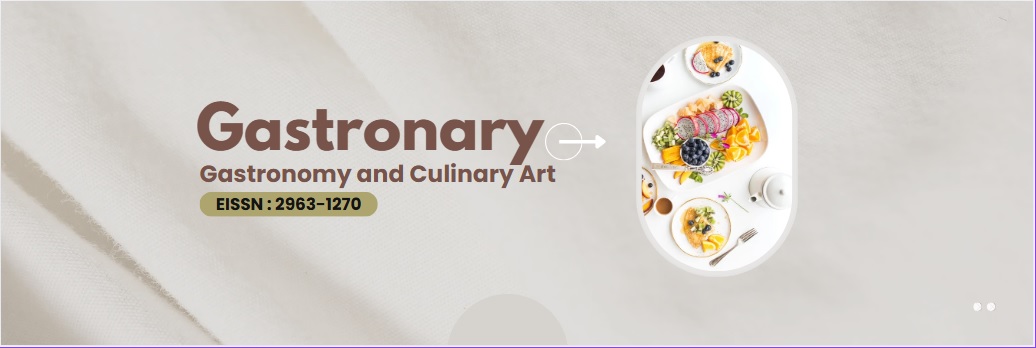Overview of The Promotion of Seblak SMEs Culinary Products through a Consumer Preference Approach
Case Study Seblak Seuhah
DOI:
https://doi.org/10.36276/gastronomyandculinaryart.v2i1.423Keywords:
Traditional Food, Promotion, Culinary, SeblakAbstract
Indonesia is rich in natural and cultural products that can be profitable business opportunities. Among the cultural products, there are regional specialties. One of them is seblak. Seblak is a traditional Sundanese food that is known to come from the city of Parahyangan with a savory and spicy taste. The word seblak comes from the Sundanese 'segak' which means to sting. The meaning of seblak is also indicated for the cikur or kencur seasoning which is used as a flavoring dish. Seblak is also given additional ingredients. Apart from being a business area, it can also preserve and maintain the diversity of Indonesian culture, especially the diversity of Indonesian cuisine. This research is a study entitled a review of the promotion of culinary products of Seblak Small and Medium Enterprises (SMEs through a consumer preference approach (case study: Seblak Seuhah) to increase sales. The purpose of this study is to provide an overview of the forms of promotion that are carried out by companies today. Consumer preferences to explain the research results obtained by the researcher. The results of this study are to provide an overview of the relationship between promotion through digital marketing and consumer decisions. The final result of this study is to display detailed information about Seblak Seuhah SMEs in Bandung and also data that can support the promotion of Seblak Seuhah SMEs in Bandung.
References
Atteng, S. P., Asih, R. S., Aliyyatussaadah, I., Kamila, R., & Nana, F. M. A. (2021).
Tren Kuliner Seblak Sebagai Faktor Pendukung Perekonomian Masyarakat di Era Milenial. De Cive : Jurnal Penelitian Pendidikan Pancasila Dan Kewarganegaraan, 1(3), 73–78. URL https://doi.org/10.56393/decive.v1i3.289
Dewi, T. (2011). Kearifan Lokal Makanan Tradisional. Manuskripta : Jurnal
Ilmiah Perhimpunan Naskah Nusantara atau Masyarakat Pernaskahan Nusantara, 1(1), 161-182. URL https://doi.org/10.33656/manuskripta.v1i1.9
Intan, R. (2014). Kiat Penjual Makanan Tradisional Dalam Menembus
Pasar. Pantajala : Jurnal Penelitian Sejarah dan Budaya, 6(2), 315-328. URL http://dx.doi.org/10.30959/patanjala.v6i2.202
Nadya, Nadya. (2016). Peran Digital Marketing dalam Eksistensi Bisnis
Kuliner Seblak Jeletet Murni. Jurnal Riset Manajemen dan Bisnis, 1(2), 133-144. URL https://dx.doi.org/10.36226/jrmb.v1i2.17
SubakirA. A., Hubeis, M., & Trilaksani, W. (2021). Strategi Peningkatan
Konsumsi Ikan pada Masyarakat Berpendapatan Rendah Di Provinsi Jawa Tengah. MANAJEMEN IKM: Jurnal Manajemen Pengembangan Industri Kecil Menengah, 15(1), 70-76. URL https://doi.org/10
Tambunan, T. (2022). UMKM di Indonesia : Perkembangan, Kendala dan
Tantangan. Jakarta : Prenada Media
Downloads
Published
How to Cite
Issue
Section
Categories
License
Copyright (c) 2023 Amanda Faradina Azahra

This work is licensed under a Creative Commons Attribution-ShareAlike 4.0 International License.






